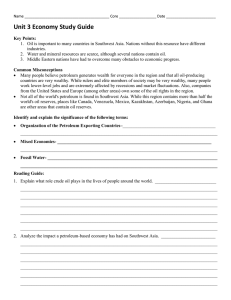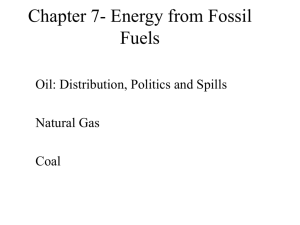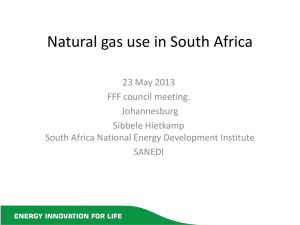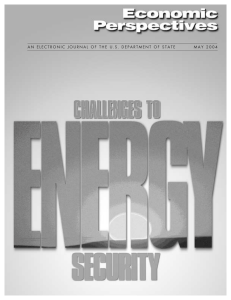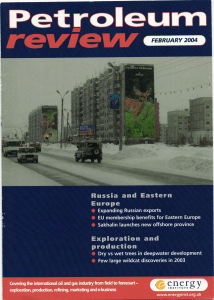Natural Gas Raymond J. Kopp
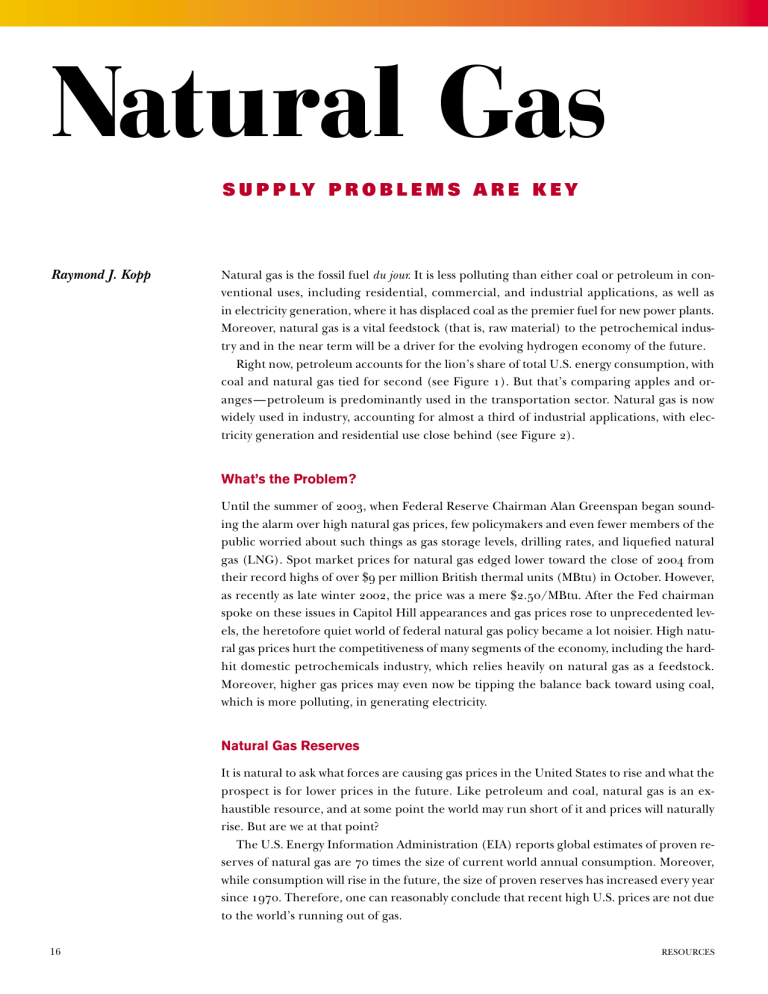
16
Natural Gas
S U P P L Y P R O B L E M S A R E K E Y
Raymond J. Kopp
Natural gas is the fossil fuel du jour.
It is less polluting than either coal or petroleum in conventional uses, including residential, commercial, and industrial applications, as well as in electricity generation, where it has displaced coal as the premier fuel for new power plants.
Moreover, natural gas is a vital feedstock (that is, raw material) to the petrochemical industry and in the near term will be a driver for the evolving hydrogen economy of the future.
Right now, petroleum accounts for the lion’s share of total U.S. energy consumption, with coal and natural gas tied for second (see Figure 1 ). But that’s comparing apples and oranges — petroleum is predominantly used in the transportation sector. Natural gas is now widely used in industry, accounting for almost a third of industrial applications, with electricity generation and residential use close behind (see Figure 2 ).
What’s the Problem?
Until the summer of 2003 , when Federal Reserve Chairman Alan Greenspan began sounding the alarm over high natural gas prices, few policymakers and even fewer members of the public worried about such things as gas storage levels, drilling rates, and liquefied natural gas (LNG). Spot market prices for natural gas edged lower toward the close of 2004 from their record highs of over $ 9 per million British thermal units (MBtu) in October. However, as recently as late winter 2002, the price was a mere $ 2 .
50 /MBtu. After the Fed chairman spoke on these issues in Capitol Hill appearances and gas prices rose to unprecedented levels, the heretofore quiet world of federal natural gas policy became a lot noisier. High natural gas prices hurt the competitiveness of many segments of the economy, including the hardhit domestic petrochemicals industry, which relies heavily on natural gas as a feedstock.
Moreover, higher gas prices may even now be tipping the balance back toward using coal, which is more polluting, in generating electricity.
Natural Gas Reserves
It is natural to ask what forces are causing gas prices in the United States to rise and what the prospect is for lower prices in the future. Like petroleum and coal, natural gas is an exhaustible resource, and at some point the world may run short of it and prices will naturally rise. But are we at that point?
The U.S. Energy Information Administration (EIA) reports global estimates of proven reserves of natural gas are 70 times the size of current world annual consumption. Moreover, while consumption will rise in the future, the size of proven reserves has increased every year since 1970 . Therefore, one can reasonably conclude that recent high U.S. prices are not due to the world’s running out of gas.
RESOURCES
More important than aggregate global reserves, however, is their distribution. Natural gas reserves are not as concentrated as crude oil (with over 60 percent of all reserves located in the Middle East), but the United States is not heavily endowed with gas deposits (see Figure 3 ). The largest gas suppliers are located in the Middle East, Eastern Europe, and countries of the former Soviet Union, which together have over 70 percent of known reserves.
The large gas consumers — North America and Western Europe — have only 7 percent. At current rates, U.S. reserves are about eight to nine times greater than annual consumption, which is considerably less than the world reserve-to-consumption ratio.
All things being equal, lower domestic reserves suggest that exploration and extraction costs will be greater in the United States and, so too will be delivered natural gas prices. However, to the extent there are integrated competitive world markets for gas, as there are for crude oil, gas prices should not differ from one county to another by more than the cost of transport. Unless gas pipelines link supplying and consuming countries, however, transport of natural gas becomes challenging, requiring specialized tankers and port facilities that are quite different from petroleum tankers and ports. At the present time, the United States has only four ports capable of importing natural gas from the countries with the greatest reserves.
These and other factors contribute to large price discrepancies from country to country.
Natural gas is now widely used in industry, accounting for almost a third of industrial appli-
Production
Reserves are only an estimate of what is in the ground. Annual production data describe how much gas is actually being extracted. EIA forecasts U.S. production to grow at an annual rate of 0 .
7 percent over the next 20 years, with consumption to grow at 1 .
6 percent. Herein lies the problem. EIA cautions that regulatory and investment uncertainty exists in making those natural gas supplies available. Failure of investments to materialize or approvals to be granted will lead to upward price pressure on gas. And even with the anticipated added domestic production, a significant shortfall will still have to be augmented with imports, which are expected to grow by 4 .
5 percent over the coming two decades.
cations, with electricity generation and residential use close behind.
Prices and Increased Supply
Natural gas prices are determined by the interplay of supply and demand. The overall level of economic activity, continued use of gas to fire new electric power plants, and efforts at conservation are all factors affecting the long-term demand for natural gas. However, it is the factors affecting supply that are drawing the greatest attention from policymakers and analysts.
The most straightforward way to increase U.S. supply is to drill more gas wells, but with prices at all-time highs, the economics of natural gas suggests there is likely as much drilling going on now in the United States as the available industry infrastructure can support. Increasing the rate of domestic exploration is problematic for two reasons: drilling is taking place in the same, mostly depleted fields, and governmental restrictions currently do not allow additional drilling in new fields offshore (California and Florida) and in the intermountain West. As might be predicted, many are opposed to drilling in these environmentally sensitive areas, including the president’s brother, Florida Governor Jeb Bush.
WINTER 2005 17
Sources of renewable energy, such as wind power, are important components of the country’s energy portfolio going forward, but the questions now are how much natural gas can we expect renewables to displace, how fast, and at what cost?
Others argue for more drilling and extraction of natural gas from the oil fields in Alaska.
But getting the gas from Alaska to the lower 48 will require a large and expensive pipeline project. Language in a military construction appropriations bill passed in October 2004 smoothed the federal regulatory hurdles for the pipeline construction and provided some
$ 18 billion in loan guarantees but did not include federal guarantees on the price of natural gas once the pipeline is operating. It remains to be seen if these “sweeteners” will bring forth the needed private investment.
A third enhancement to supply is imported liquefied natural gas (LNG), which becomes economically competitive to domestic gas supply when the price of domestic gas rises above
$ 3 .
50 /MBtu. This is well below the current spot and futures prices—indicating that the economic climate for LNG is right. Although the troubled Middle East has large natural gas reserves, Venezuela and several Caribbean countries do as well, suggesting that increased LNG imports might not carry the added international political burdens associated with oil.
But ports accepting LNG tankers are large, capital-intensive industrial facilities that are expensive to build and must be operated for long periods to provide suitable rates of return to investors. Moreover, there are those who believe such coastal facilities will have negative effects on the local environment and might make tempting targets for terrorists as well.
Another option to consider is using renewable energy to stretch existing natural gas supplies instead of increasing them. Sources of renewable energy, such as wind power, are important components of the country’s energy portfolio going forward, but the questions now are how much natural gas can we expect renewables to displace, how fast, and at what cost?
Of course, gas supplies can be stretched through straightforward energy conservation as well.
In March 2003 , then Energy Secretary Spencer Abraham asked the National Petroleum
Council (a federally chartered advisory committee) to undertake a major study of natural gas supply and demand through 2025 . In addition to increased efficiency and conservation, the council report recommended increased access to domestic gas deposits and reduced permitting impediments to development of natural gas resources in the lower 48 states. The council also argued in favor of legislation enabling the construction of a new Alaska gas pipeline and rapid, one-year processing of LNG project permit applications.
The recommended legislation has now passed, and it’s up to private investors to make their move. Opening up more lands to exploration and extraction, whether onshore or offshore, will require a heavy political fight and even if successful, will have only near-term benefits because domestic gas reserves in the lower 48 are limited and unlikely to increase by much. So perhaps the greatest emphasis should be placed on imports and LNG.
While LNG fleets and facilities are costly investments, the economics of large-scale LNG importation suggests investment funds will be forthcoming. The real obstacle is siting the port facilities. Safety and environmental concerns are raised everywhere a new LNG port is proposed, and increased fear of terrorist attacks on LNG tankers as they enter ports has only heightened fears and opposition.
These facilities are too large, too expensive, and too politically vulnerable to ram down the throats of reluctant communities. Some rational process by which the safety, security, and environmental threats are credibly assessed, standards for acceptable risks established, and siting decisions made without years of bureaucratic wrangling must be found — and found quickly — for natural gas to be a viable option in the U.S. energy future.
■
18 RESOURCES
R E N EWAB LE E N E RGY
N UCLEAR
POWE R
COAL
NATU RAL GAS PETROLE U M
6 8 23 23 40%
Figure 1:
Projected Composition of U.S. Energy Demand in 2005
SOURCE: U.S. ENERGY INFORMATION
ADMINISTRATION, 2005
8
OTH E R
COM M E RCIAL
E LECTR IC POWE R R E S I D E NTIAL I N D USTR IAL
14 23 23 32%
Figure 2:
Projected Composition of U.S. Natural Gas
Demand in 2005
WE STE R N E U ROPE
CE NTRAL AN D SOUTH AM E R ICA
NORTH AM E R ICA
AFR ICA AS IA &
OCEAN IA
EASTE R N E U ROPE &
FOR M E R SOVI ET U N ION
M I D D LE EAST
3 4 4 7 8 35 39%
WINTER 2005
Figure 3:
Current Distribution of World Natural Gas
Reserves
19

